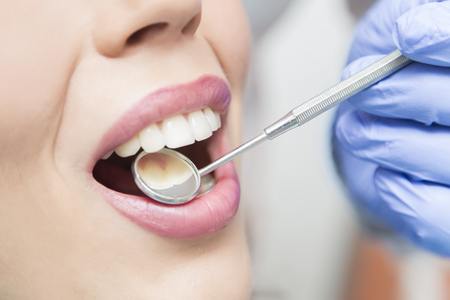1. Understanding Sensitivity: Why Some Teeth React to Whitening
Tooth sensitivity is a common issue that can make whitening treatments uncomfortable for some people. If youve ever felt a sharp or tingling sensation when consuming hot, cold, sweet, or acidic foods, you might have sensitive teeth. But why does this happen, and how does it relate to teeth whitening?
Causes of Tooth Sensitivity
To understand why some whitening treatments trigger discomfort, its important to know what causes tooth sensitivity in the first place. Here are some common reasons:
| Cause | Description |
|---|---|
| Enamel Erosion | The protective outer layer of your teeth wears down due to acidic foods, aggressive brushing, or aging. |
| Gum Recession | The gum tissue pulls away from the teeth, exposing the more sensitive dentin underneath. |
| Cavities and Tooth Decay | Cavities create openings in the enamel, making teeth more vulnerable to sensitivity. |
| Poor Oral Hygiene | Buildup of plaque and tartar can contribute to enamel damage and sensitivity. |
| Poorly Fitted Fillings or Crowns | If dental work isnt properly fitted, it can lead to exposed dentin and increased sensitivity. |
How Whitening Treatments Affect Sensitive Teeth
Teeth whitening products often contain bleaching agents like hydrogen peroxide or carbamide peroxide. While these ingredients effectively remove stains, they can also penetrate the enamel and reach the dentin layer, where nerve endings are more exposed. This process can temporarily increase sensitivity, especially for those who already have weakened enamel or receding gums.
The Role of Whitening Strength and Frequency
The strength and frequency of whitening treatments play a key role in determining how much sensitivity you may experience. Here’s a general guideline:
| Treatment Type | Sensitivity Level |
|---|---|
| Mild Over-the-Counter Whitening Strips | Low to Moderate Sensitivity |
| Professional In-Office Whitening (High Concentration) | Moderate to High Sensitivity |
| Whitening Toothpaste (Gentle Formula) | Minimal Sensitivity |
Tips for Minimizing Discomfort During Whitening
- Use a Desensitizing Toothpaste: Products containing potassium nitrate or fluoride help strengthen enamel and reduce discomfort.
- Avoid Overuse: Whitening too frequently can exacerbate sensitivity issues.
- Select Low-Peroxide Formulas: Lower concentrations of bleaching agents may cause less irritation.
- Pace Yourself: Instead of back-to-back treatments, allow time between sessions for your teeth to recover.
- Avoid Acidic Foods and Drinks: These can further weaken enamel and increase sensitivity after whitening.
If you have sensitive teeth but still want a brighter smile, dont worry—there are solutions that work without causing too much discomfort. The key is understanding your teeth’s condition and choosing gentle yet effective whitening methods.
2. Safe Whitening Ingredients for Sensitive Teeth
When you have sensitive teeth, finding a whitening solution that doesn’t cause discomfort is essential. Many traditional whitening products contain strong bleaching agents that can lead to irritation. Fortunately, there are gentler alternatives designed to brighten your smile without the pain.
Hydrogen Peroxide Alternatives
Hydrogen peroxide is a common ingredient in teeth whitening products, but it can sometimes be too harsh for sensitive teeth. Instead, consider these milder options:
| Ingredient | Benefits |
|---|---|
| Papain (Papaya Enzyme) | Gently breaks down stains without damaging enamel. |
| Bromelain (Pineapple Enzyme) | A natural stain remover that helps whiten teeth safely. |
| Sodium Bicarbonate (Baking Soda) | Mild abrasive action removes surface stains while maintaining enamel integrity. |
| Coconut Oil (Oil Pulling) | A natural detoxifier that may help reduce plaque and brighten teeth over time. |
Desensitizing Agents for Comfort
If you experience sensitivity when whitening your teeth, look for products that include desensitizing agents. These ingredients help protect your enamel and minimize discomfort:
- Potassium Nitrate: Helps reduce nerve sensitivity and discomfort during whitening.
- Sodium Fluoride: Strengthens enamel and provides protection against future sensitivity.
- Aloe Vera: Soothes gums and reduces irritation caused by whitening treatments.
- Xylitol: Helps maintain oral health while preventing bacteria buildup.
TIPS: Choosing the Right Whitening Product
If you’re unsure which product is best for your sensitive teeth, keep these tips in mind:
Avoid High-Concentration Bleaching Agents
Select whitening gels or toothpaste with lower peroxide concentrations or peroxide-free formulas to prevent irritation.
Look for ADA-Approved Products
The American Dental Association (ADA) seal ensures a product is safe and effective for whitening.
Use Shorter Application Times
If using whitening strips or trays, reduce the application time to minimize sensitivity.
Add a Desensitizing Toothpaste to Your Routine
A fluoride-based or potassium nitrate toothpaste can help strengthen enamel and reduce sensitivity before starting a whitening treatment.
![]()
3. Affordable At-Home Whitening Solutions
Whitening your teeth at home doesn’t have to be expensive, even if you have sensitive teeth. There are plenty of budget-friendly options that can help brighten your smile without causing discomfort. Below, we’ll explore some of the best at-home whitening solutions, including toothpaste, strips, and natural remedies.
Whitening Toothpaste for Sensitive Teeth
Using a whitening toothpaste designed for sensitive teeth is one of the easiest and most affordable ways to maintain a bright smile. These toothpastes contain gentle whitening agents like hydrogen peroxide or baking soda while also including ingredients that help reduce sensitivity.
| Product | Main Ingredients | Benefits |
|---|---|---|
| Sensodyne Extra Whitening | Potasium Nitrate, Fluoride | Whitens gently while reducing sensitivity |
| Crest 3D White Gentle Routine | Mild Abrasives, Fluoride | Evens out stains without causing irritation |
| Toms of Maine Simply White | Naturally Derived Silica, Fluoride-Free | A natural option for gentle whitening |
Sensitive-Friendly Whitening Strips
If you’re looking for a more noticeable whitening effect, whitening strips formulated for sensitive teeth can be a great option. These strips contain lower concentrations of bleaching agents to minimize irritation while still providing results.
- Crest 3D Whitestrips Sensitive: Specially designed for people with sensitive teeth, these strips use less peroxide but still effectively whiten over time.
- Zimba Teeth Whitening Strips: Made with natural ingredients like coconut oil, these strips provide a gentler approach to whitening.
- Lumist Advanced Whitening Strips: A peroxide-free option that relies on gentle whitening technology to brighten your teeth.
Natural Remedies for Gentle Whitening
If you prefer a more natural approach, several home remedies can help whiten your teeth while being gentle on sensitivity.
Baking Soda & Water Paste
Baking soda has mild abrasive properties that can help remove stains without damaging enamel. Simply mix a small amount with water to create a paste and brush gently.
Coconut Oil Pulling
This ancient technique involves swishing coconut oil in your mouth for 10-15 minutes. It may help reduce plaque buildup and surface stains over time.
Strawberry & Baking Soda Mix
The malic acid in strawberries combined with baking soda can provide mild whitening effects. Mash a strawberry and mix it with baking soda before applying it to your teeth for a few minutes.
No matter which method you choose, consistency is key to achieving and maintaining a brighter smile. By selecting products designed for sensitive teeth, you can enjoy effective whitening without discomfort.
4. Professional Treatments: When to See a Dentist
If you have sensitive teeth and over-the-counter whitening products aren’t giving you the results you want, it might be time to consider professional treatments. Dentists offer customized solutions that can effectively whiten your teeth while minimizing discomfort.
When Is Professional Whitening the Best Choice?
While at-home whitening kits work for many people, there are certain situations where professional treatment is the better option:
- Severe Sensitivity: If drugstore products cause pain or irritation, a dentist can use gentler methods tailored to your needs.
- Deep Stains: Some discoloration, such as those caused by medications or aging, may require stronger whitening agents only available in a dental office.
- Faster Results: Professional whitening can achieve noticeable results in just one visit compared to weeks of at-home treatments.
- Even Whitening: If you have uneven staining, a dentist can ensure consistent whitening across all teeth.
How Dentists Customize Whitening for Sensitive Teeth
Dentists understand that sensitivity is a common concern and can adjust their approach accordingly. Here’s how they personalize treatments:
| Customization Method | How It Helps |
|---|---|
| Lower Concentration Peroxide | Uses milder bleaching agents to reduce irritation. |
| Desensitizing Gel | A special gel is applied before or after treatment to minimize discomfort. |
| Shorter Treatment Sessions | Lowers exposure time to whitening agents to prevent sensitivity. |
| Custom-Fitted Trays | Avoids contact with gums, reducing irritation and pain. |
The Benefits of Seeing a Dentist for Whitening
If youre hesitant about whitening due to sensitivity, visiting a dentist offers several advantages:
- Sensitivity Management: Dentists use products designed to protect your enamel and reduce discomfort.
- Longer-Lasting Results: Professional treatments often provide better and more lasting results than store-bought options.
- A Safe Approach: Your dentist ensures your gums and enamel stay protected throughout the process.
- A Personalized Plan: Youll get advice on maintaining your white smile without triggering sensitivity.
Your Next Steps
If youve struggled with tooth sensitivity but still want a whiter smile, consider booking an appointment with your dentist. They can assess your oral health, discuss your goals, and recommend the safest and most effective whitening option for you.
5. Tips to Maintain a Brighter Smile Without Irritation
Keeping your teeth white while avoiding sensitivity can be a challenge, but with the right habits, you can enjoy long-lasting results without discomfort. Here are some expert-backed tips to help you maintain a brighter smile without irritation.
Stick to a Gentle Oral Hygiene Routine
Using the right products and techniques can make all the difference in keeping your teeth white and healthy. Follow these simple oral care tips:
- Use a soft-bristled toothbrush: Hard bristles can wear down enamel and worsen sensitivity.
- Opt for a non-abrasive whitening toothpaste: Look for formulas designed for sensitive teeth.
- Brush gently: Use light pressure and circular motions to avoid damaging enamel.
- Floss daily: Removing plaque between teeth prevents staining and promotes gum health.
- Rinse with alcohol-free mouthwash: Harsh ingredients can increase sensitivity.
Avoid Staining Foods and Drinks
Certain foods and beverages can cause discoloration over time. Try to limit or modify your intake of these common culprits:
| Avoid or Limit | Better Alternatives |
|---|---|
| Coffee & Tea | Iced coffee with a straw or herbal tea |
| Soda & Dark Juices | Sparkling water or diluted fruit juice |
| Red Wine | White wine or lighter-colored drinks |
| Soy Sauce & Balsamic Vinegar | Lighter dressings like olive oil & lemon juice |
| Berries (Blueberries, Blackberries) | Avoid direct contact or rinse after eating |
Drink Plenty of Water
Sipping water throughout the day helps wash away food particles and reduces staining. If you consume dark-colored beverages, try drinking water immediately afterward to minimize their effects on your enamel.
Use Whitening Products in Moderation
If you use whitening strips, gels, or trays, follow the recommended usage instructions carefully. Overuse can lead to increased sensitivity and enamel erosion. Consider switching to gentler alternatives such as whitening toothpaste or mouthwash designed for sensitive teeth.
Schedule Regular Dental Checkups
Your dentist can provide professional cleanings that remove surface stains and check for any signs of enamel wear or sensitivity issues. Visiting every six months helps maintain both your oral health and the brightness of your smile.
Add Calcium-Rich Foods to Your Diet
A strong enamel layer helps protect against staining and sensitivity. Incorporate these calcium-rich foods into your diet:
- Dairy products like milk, cheese, and yogurt
- Nuts such as almonds and cashews
- Leafy greens like spinach and kale
- Canned fish with soft bones (e.g., sardines)
- Calcium-fortified plant-based milk alternatives
By following these simple tips, you can keep your smile bright while minimizing discomfort from tooth sensitivity. A combination of good oral hygiene, mindful eating habits, and regular dental care will help you maintain long-lasting whitening results without irritation.


